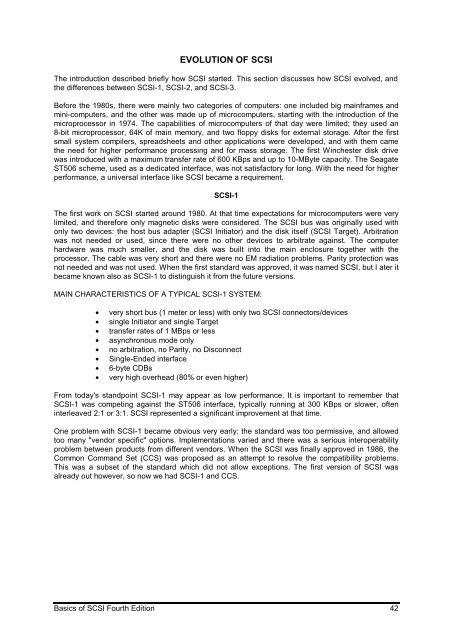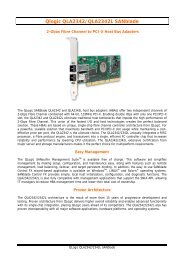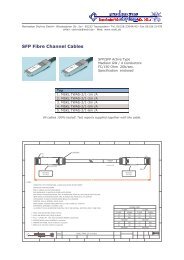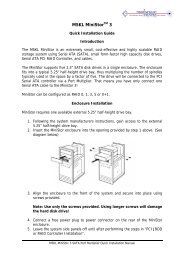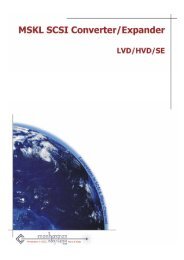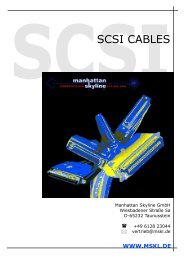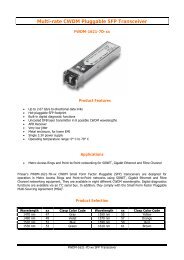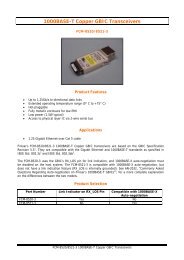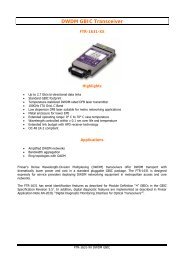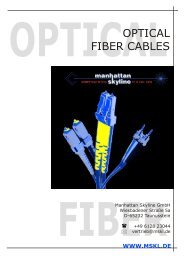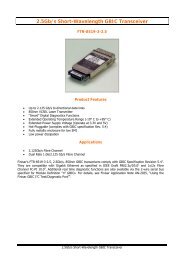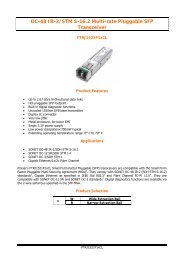Basics of SCSI Fourth Edition - Manhattan Skyline GmbH
Basics of SCSI Fourth Edition - Manhattan Skyline GmbH
Basics of SCSI Fourth Edition - Manhattan Skyline GmbH
Create successful ePaper yourself
Turn your PDF publications into a flip-book with our unique Google optimized e-Paper software.
EVOLUTION OF <strong>SCSI</strong><br />
The introduction described briefly how <strong>SCSI</strong> started. This section discusses how <strong>SCSI</strong> evolved, and<br />
the differences between <strong>SCSI</strong>-1, <strong>SCSI</strong>-2, and <strong>SCSI</strong>-3.<br />
Before the 1980s, there were mainly two categories <strong>of</strong> computers: one included big mainframes and<br />
mini-computers, and the other was made up <strong>of</strong> microcomputers, starting with the introduction <strong>of</strong> the<br />
microprocessor in 1974. The capabilities <strong>of</strong> microcomputers <strong>of</strong> that day were limited; they used an<br />
8-bit microprocessor, 64K <strong>of</strong> main memory, and two floppy disks for external storage. After the first<br />
small system compilers, spreadsheets and other applications were developed, and with them came<br />
the need for higher performance processing and for mass storage. The first Winchester disk drive<br />
was introduced with a maximum transfer rate <strong>of</strong> 600 KBps and up to 10-MByte capacity. The Seagate<br />
ST506 scheme, used as a dedicated interface, was not satisfactory for long. With the need for higher<br />
performance, a universal interface like <strong>SCSI</strong> became a requirement.<br />
<strong>SCSI</strong>-1<br />
The first work on <strong>SCSI</strong> started around 1980. At that time expectations for microcomputers were very<br />
limited, and therefore only magnetic disks were considered. The <strong>SCSI</strong> bus was originally used with<br />
only two devices: the host bus adapter (<strong>SCSI</strong> Initiator) and the disk itself (<strong>SCSI</strong> Target). Arbitration<br />
was not needed or used, since there were no other devices to arbitrate against. The computer<br />
hardware was much smaller, and the disk was built into the main enclosure together with the<br />
processor. The cable was very short and there were no EM radiation problems. Parity protection was<br />
not needed and was not used. When the first standard was approved, it was named <strong>SCSI</strong>, but I ater it<br />
became known also as <strong>SCSI</strong>-1 to distinguish it from the future versions.<br />
MAIN CHARACTERISTICS OF A TYPICAL <strong>SCSI</strong>-1 SYSTEM:<br />
• very short bus (1 meter or less) with only two <strong>SCSI</strong> connectors/devices<br />
• single Initiator and single Target<br />
• transfer rates <strong>of</strong> 1 MBps or less<br />
• asynchronous mode only<br />
• no arbitration, no Parity, no Disconnect<br />
• Single-Ended interface<br />
• 6-byte CDBs<br />
• very high overhead (80% or even higher)<br />
From today's standpoint <strong>SCSI</strong>-1 may appear as low performance. It is important to remember that<br />
<strong>SCSI</strong>-1 was competing against the ST506 interface, typically running at 300 KBps or slower, <strong>of</strong>ten<br />
interleaved 2:1 or 3:1. <strong>SCSI</strong> represented a significant improvement at that time.<br />
One problem with <strong>SCSI</strong>-1 became obvious very early; the standard was too permissive, and allowed<br />
too many "vendor specific" options. Implementations varied and there was a serious interoperability<br />
problem between products from different vendors. When the <strong>SCSI</strong> was finally approved in 1986, the<br />
Common Command Set (CCS) was proposed as an attempt to resolve the compatibility problems.<br />
This was a subset <strong>of</strong> the standard which did not allow exceptions. The first version <strong>of</strong> <strong>SCSI</strong> was<br />
already out however, so now we had <strong>SCSI</strong>-1 and CCS.<br />
<strong>Basics</strong> <strong>of</strong> <strong>SCSI</strong> <strong>Fourth</strong> <strong>Edition</strong> 42


